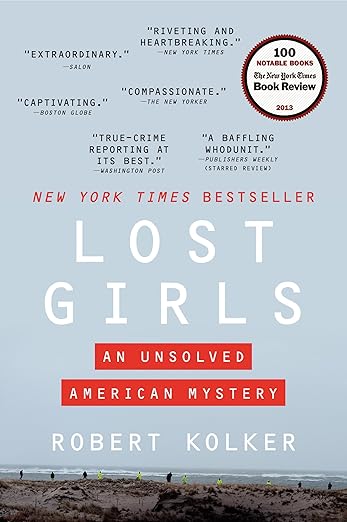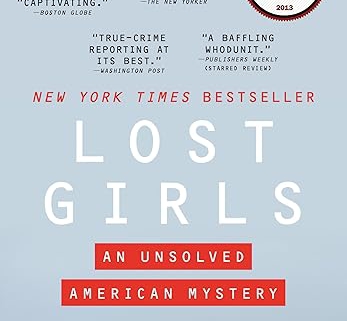In-Depth Review Lost Girls: An Unsolved American Mystery by Robert Kolker
“A Haunting Exploration of Victims, Society, and Justice Unfulfilled”
Overview

Kolker expertly weaves together the disparate threads of these women’s lives, from Maureen Brainard-Barnes’s attempt to escape the tightening grip of poverty in Connecticut, driving her toward sex work and away from her young son, to Melissa Barthelemy’s struggle to control addiction while searching for stability in an unforgiving world. Through vivid snapshots—Megan Waterman’s laughter echoing through a motel parking lot as she called her daughter, Amber Lynn Costello’s vibrant smile in a blurred Craigslist photo—we sense the humanity behind the headlines and the raw urgency that propelled each woman toward perilous autonomy.
As the narrative moves from backroom motel negotiations to the stifling corridors of Suffolk County PD’s command center, readers witness systemic indifference and bureaucratic inertia at every twist. Kolker brings to life the tensions in local communities—Oak Beach residents wary of PR backlash, detectives caught between jurisdictional disputes, and journalists hungry for a sensational scoop. Against this backdrop, the investigation becomes a haunting mirror reflecting societal blind spots: class bias, gender stigma, and the friction between truth-seeking and public image management.
Pros of Lost Girls
1. Humanizing the Victims
Kolker’s greatest achievement lies in his compassionate portrayal of the victims. Unlike many true crime narratives that reduce victims to statistics or plot devices, Lost Girls dedicates entire chapters to each woman’s life. For example:
- Shannan Gilbert, whose frantic 911 call and disappearance sparked the investigation, is depicted as a charismatic but troubled young woman battling mental health issues.
- Maureen Brainard-Barnes, a single mother from Connecticut, is shown grappling with poverty and a fractured family dynamic.
- Melissa Barthelemy and Amber Lynn Costello are portrayed as complex individuals navigating addiction and economic despair.
By interviewing families and friends, Kolker reconstructs their dreams, mistakes, and resilience, challenging stereotypes about sex workers.
2. Exposing Systemic Failures
The book critiques the Suffolk County Police Department’s mishandling of the case. Kolker highlights how the victims’ status as sex workers led to delayed investigations and public apathy. For instance:
- Shannan’s disappearance was initially dismissed as a “crazy hooker” episode, delaying the search for her body.
- The discovery of four bodies in burlap sacks—after Shannan’s case—revealed a pattern of negligence, with jurisdictional disputes and lack of forensic urgency.
This systemic indifference underscores broader societal issues, such as classism and the stigmatization of marginalized communities.
3. Exploration of Online Sex Work
Kolker provides a nuanced examination of Craigslist’s role in modern prostitution. He details how the platform offered these women autonomy but also exposed them to lethal risks. For example:
- Megan Waterman used Craigslist to support her daughter but faced escalating danger from clients.
- The anonymity of online interactions made tracking predators nearly impossible, a reality still relevant today.
This analysis elevates the book beyond true crime into a socio-political commentary.
4. Narrative Structure and Prose
The book is meticulously researched and elegantly written. Kolker’s journalistic rigor shines in his interviews with families, law enforcement, and Oak Beach residents. His prose is both clinical and empathetic, avoiding melodrama while evoking emotional resonance. Descriptions of Long Island’s eerie landscapes—marshes, dunes, and gated communities—add a gothic atmosphere.
Cons of Lost Girls
1. Lack of Investigative Depth
While the victims’ stories are richly detailed, the police investigation feels underexplored. Critics note that Kolker had limited access to law enforcement sources, resulting in a lopsided narrative. For example:
- The book speculates about potential suspects (e.g., Dr. Peter Hackett, a local physician) but offers little forensic analysis.
- Key questions—such as why the killer used burlap sacks or how he evaded detection—remain unanswered.
True crime enthusiasts expecting a CSI-style procedural may find this frustrating.
2. Overwhelming Cast of Characters
With five victims, their families, boyfriends, pimps, and Oak Beach residents, the narrative becomes convoluted. Readers may struggle to track relationships, such as:
- The rotating partners of Amber Lynn Costello.
- The intergenerational trauma in Shannan’s family.
A character list at the book’s end helps but is not easily referenced mid-read.
3. Unresolved Ending
As the case was unsolved when the book was published, the lack of closure may dissatisfy some. While Kolker admirably avoids sensational theories, the open-ended conclusion leaves readers with more questions than answers. The 2023 arrest of Rex Heuermann—a suspect not covered in the original edition—adds urgency for an updated version.
Rating
- Research & Writing: 5/5
- Narrative Structure: 3.5/5
- Emotional Impact: 4.5/5
- Thematic Depth: 4.5/5
Lost Girls has been praised as “one of the best true crime books of all time” (Time) and “a lashing critique of how society let these women down” (The New York Times). However, its procedural gaps and dense cast prevent a perfect score.
Critical Analysis: What Makes Lost Girls Stand Out?
1. Victim-Centered True Crime
Kolker’s focus on the victims’ humanity challenges the genre’s tendency to glorify killers. By detailing their aspirations—Melissa’s dream of owning a hair salon, Megan’s love for her daughter—he forces readers to confront their humanity. This approach has influenced newer works like I’ll Be Gone in the Dark and The Phantom Prince.
2. Socio-Economic Commentary
The book exposes how poverty and limited opportunities funneled these women into sex work. For example:
- Maureen left rural Connecticut due to stagnant wages and lack of childcare.
- Amber turned to escorting after losing her job during the 2008 recession.
Kolker implicitly critiques America’s frayed social safety net, making Lost Girls a scathing indictment of systemic inequality.
3. The Role of Technology
The rise of Craigslist and Backpage revolutionized sex work, offering both empowerment and peril. Kolker illustrates how these platforms enabled predators to exploit vulnerable women while shielding themselves behind anonymity—a theme chillingly relevant in today’s digital age.
Personal Reflections
As a reader, Lost Girls left me with a profound sense of anger and sorrow. Kolker’s portrayal of the victims’ resilience—Amber’s wit, Shannan’s humor—contrasts painfully with their brutal fates. The book’s greatest strength is its refusal to let these women be forgotten.
However, the lack of investigative progress underscores a harsh reality: marginalized victims rarely receive justice. The 2023 arrest offers hope, but Kolker’s work reminds us that countless others remain overlooked.
Who Should Read This Book?
- True Crime Enthusiasts: While light on forensics, the book offers a masterclass in empathetic storytelling.
- Social Justice Advocates: Its exploration of class, gender, and systemic neglect is incisive.
- Fans of Literary Nonfiction: Kolker’s prose rivals works by Truman Capote or Joan Didion.
Avoid if you prefer tidy resolutions or cop-centric narratives.
Final Verdict
Lost Girls: An Unsolved American Mystery is a haunting, necessary work that redefines true crime. By centering the victims and indicting societal failures, Kolker crafts a narrative that is as much about empathy as it is about mystery. While imperfect, its emotional and intellectual impact lingers long after the final page.
Recommendation: A must-read for those seeking depth and humanity in true crime. Pair with the 2020 Netflix adaptation Lost Girls for a complementary visual experience.
- Review Lost Girls: An Unsolved American Mystery by Robert Kolker
- Review: House of Earth and Blood by Sarah J. Maas
- Review: House of Sky and Breath by Sarah J. Maas
- Review: House of Flame and Shadow by Sarah J. Maas
- Review: Let Them Theory
- Review: Great Big Beautiful Life (Reese’s Book Club)
- Review: Sunrise on the Reaping
- Review: The Lost Bookshop



